OrganOOn at Electrified
Posted in: Uncategorized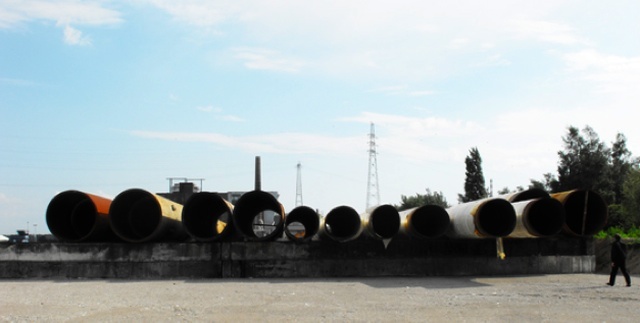

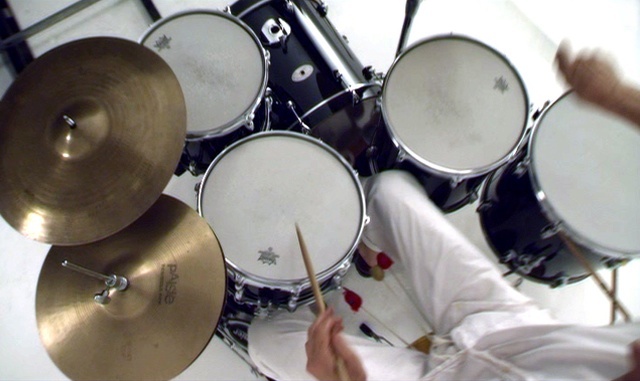
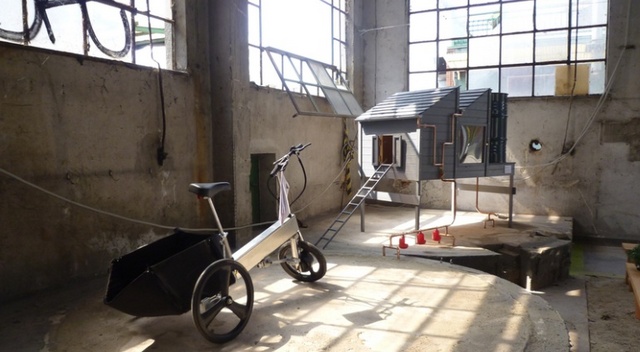
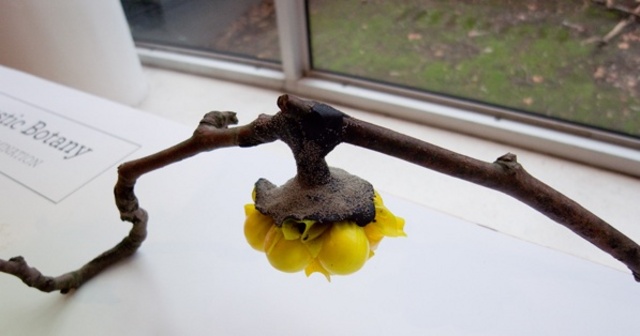
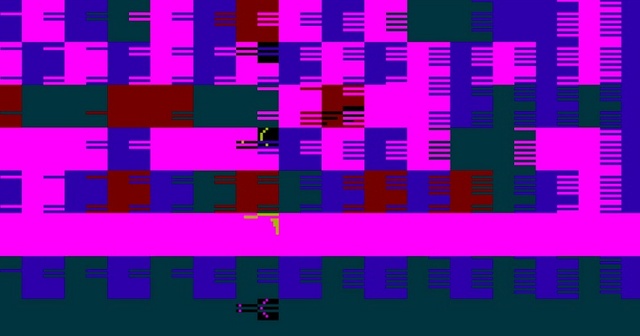
Une superbe expérience avec cet ensemble de sculptures sonores, conçues par le duo d’artistes suisses : Zimoun et Pelang. Une compilation vidéo de 8 minutes présentant ces performances à la fois minimales et visuelles. A découvrir dans la suite de l’article.
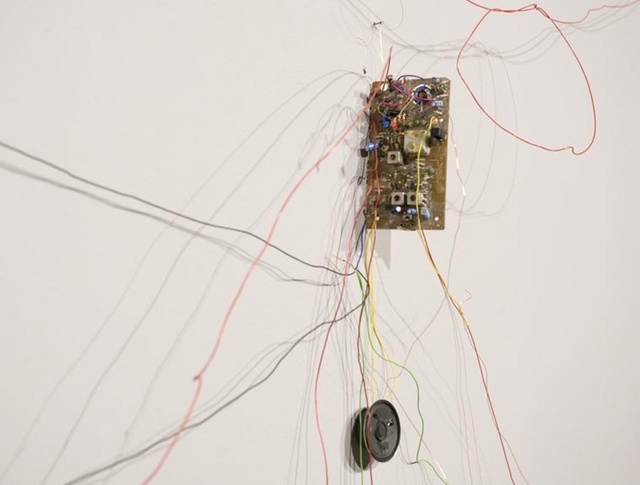
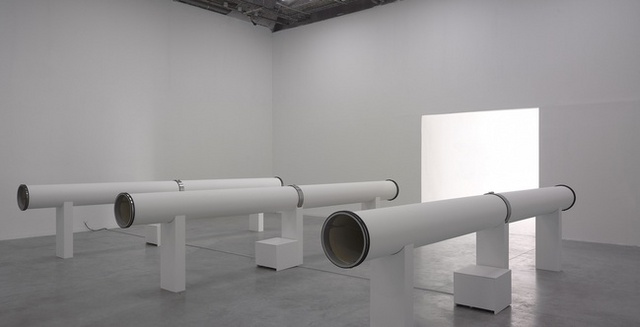
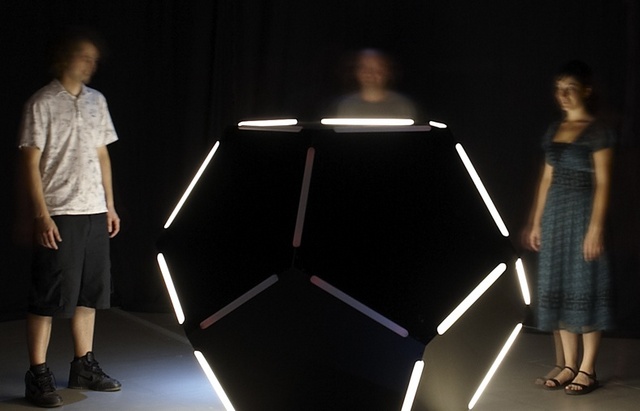
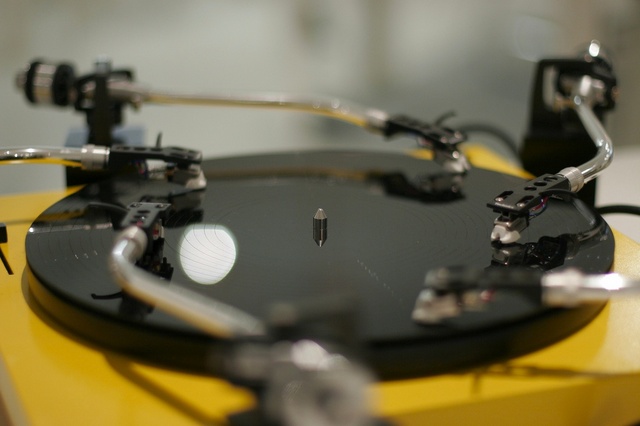
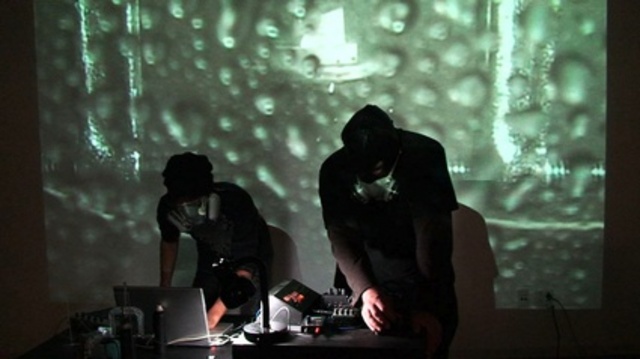
Just a quick video that will hopefully inspire you merry ways to end 2008:
Daniel Eatock spent two months in 2007 living and working in Vilnius (Lithuania). He noticed that car alarms were constantly interrupting the peace. The alarms were so sensitive that even a whisper would set them off. One day, out of sheer frustration, Eatock left his desk, found the car whose alarm had been interrupting his peace every five minutes, and waited patiently for the siren to switch on. When the siren sounded, he started dancing like a madman. He made videos of several of his car alarm dances, never touching the car, only dancing to the sound pollutants.
Seen at Nowhere, Now / Here, an exhibition that revisits the definition and perception of design.
Nowhere/Now/Here runs until Mon, April 20 , 2009 at LABoral Centro de Arte y Creación Industrial in Gijon, Spain.
Alan Dunning, Morley Hollenberg and Paul Woodrow are working since 1996 on the Einstein’s Brain, a project that explores how the brain can act as an interface between bodies and worlds in flux, that examines the idea of the world as a construct sustained through neurological processes. In collaboration with scientists, artists and technologists from around the world the team is investigating ideas about consciousness and embodiment through the realization of virtual environments and the construction of surrogate bodies.
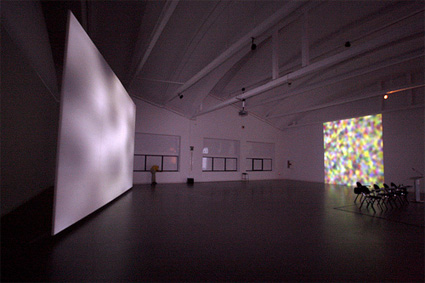
The Canadian collective has a very uncanny and captivating installation on view until mid-January at LABoral Centro de Arte y Creación Industrial. in Gijón (Spain.)
Ghosts in the Machine, uses the ideas inherent in Electronic Voice Phenomenon (EVP) to examine ways in which we construct the world and extends it to the visual. EVP is the recording of errant noises or voices that have no explainable or physical source of origin. For some, the voices are subjective interpretations (similar to some form of anthropomorphisation) of what are actually random patterns of sound. For others, the voices are genuinely mysterious, opening up for example the possibility to communicate with other realms.
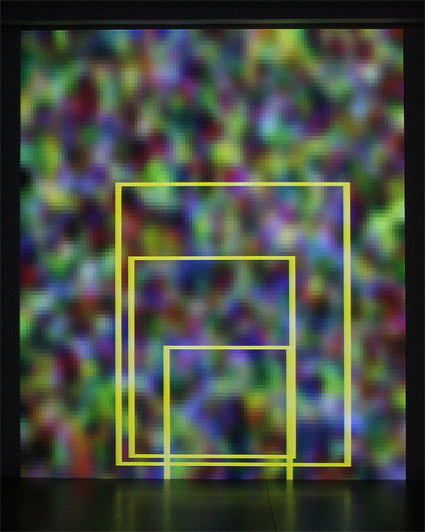
The installation Ghosts in the Machine looks simple: two large images are projected onto the walls of a room. One projection shows video static overlaid with text and the outlines of bounding boxes, the other shows b&w images of what appear to be blurry and ghost-like images of human faces. Ambient noise fills the space. Just at the threshold of recognition can be heard what appear to be human speech in different languages. A box, encloses tightly a CCD camera, only letting through the video noise inherent in the system. Audio patterns are scanned by a voice recognition system that looks for words and sentences which are then projected as words and played as voice-like sounds in the exhibition room.
Face tracking algorithms look for any combination of pixels that form the basic characteristics of a human face. When the software finds a combination of pixels akin to eyes, nose and mouth with a sufficient degree of symmetry, it draws a bounding box defining the area and zooms the area to full screen, its contrast and brightness is adjusted, blurred and desaturated to clarify the found images. More often than not the images produced fail to resolve themselves into anything recognizable. But occasionally, images are produced that are strikingly like a face although in actuality containing only the barest possibility of being so.
As the authors of the project explain: It is the very ambiguity and intedeterminacy of the images that allows the brain to reconfigure them as indexical. This work is one of several that examine systems of meaning making that rely on pattern recognition, and the problematized relationship between meaning and the meaningful.
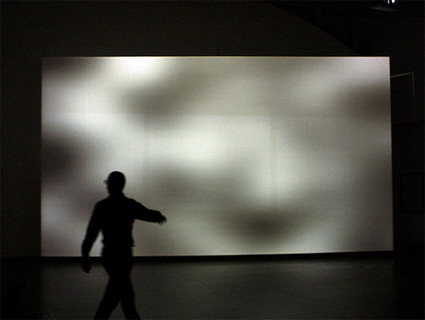
The project examines how we construct worlds, and bodies in worlds, through pareidolia, (when a vague and random stimulus is perceived as significant), apophenia (the seeing of connections where there are none) and the gestalt effect (the recognition of pattern and form).
All images courtesy LABoral Centro de Arte y Creación Industrial.
Ghosts in the Machine, produced by LABoral’s Projects Office, is on view at LABoral, in Gijón (Spain) through January 12 , 2009.
More ghosts this way ladies and gentlemen: Man Machine 2, The Museum of Jurassic Technology, Haunted pixels, (don’t) Show me the Chip, Ghost by Olaf Breuning, and a vacuum cleaner to capture goblins.
News from the graduate summer show at the Royal College of Art in London.
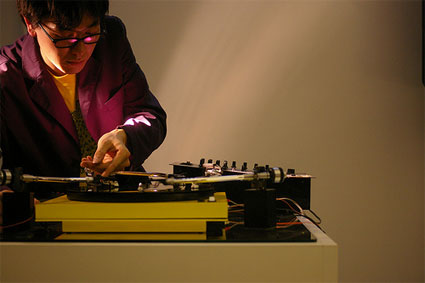
Yuri Suzuki and the Prepared Turntable
Quite a few projects made my day over there. The ones of Yuri Suzuki for example. That guy is so talented it should be illegal. He’s an artist, musician and now a fresh graduate from the Design Products department. His project is concerned with revamping and giving new forms and meanings to the almost obsolete turntable, a device which very few of us still have in their house. We don’t buy disks of CDs anymore either. Nowadays music is more abstract and immaterial than ever. Sound has been reduced to data.
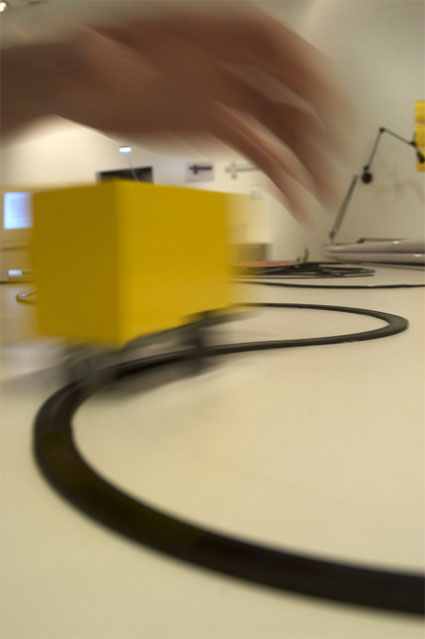
Sound Chaser
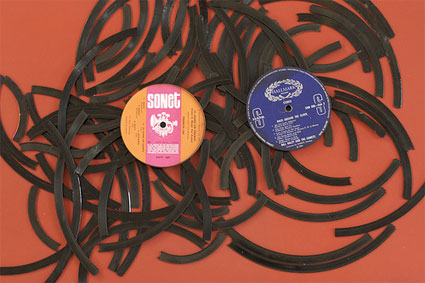
Sound Chaser
Sound Chaser looks like a little toy train that rides on record rails. You can align and connect each chipped pieces of second-hand records one to another and compose a new track that the train will play.
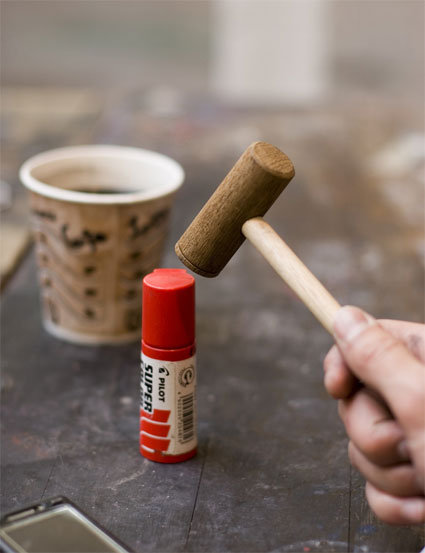
Tip Tap
The TipTap, developed in collaboration with Bahbak Hashemi-Nezhad, is a little hammer that reveals the dormant sounds around us.
A small metal tapper housed in the object taps out a rhythm on any object or surface that you hold it near to. The rhythm is set either by the user or can be defined by the controller. Alternatively, a beat can be taken from your favourite record, allowing you to play along while keeping perfectly in time. The TipTap can also synchronise with other users to make a social tapping experience.
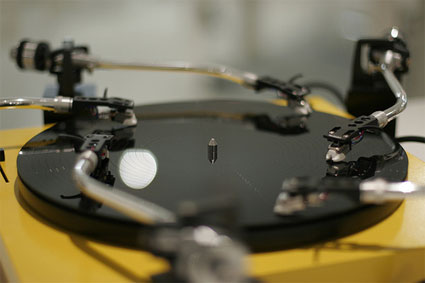
Prepared Truntable
The Prepared Turntable is an analogue answer to the digitalized DJ. The turntable has 5 tone arms, each of which can have its volume controlled by its own fader. Users can make or play music with special loop groove records.
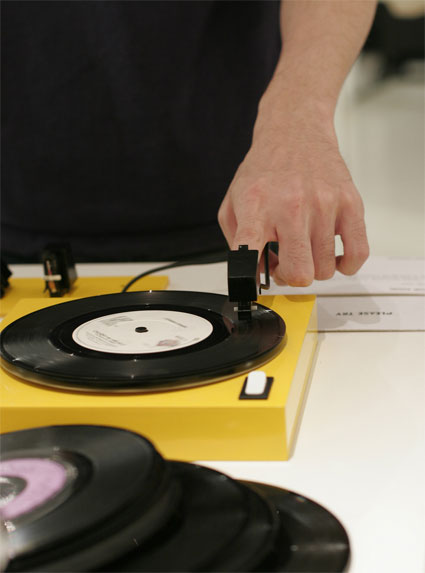
Finger Player
The Finger Player is a wearable record player. Insert your fingers into one of the little rings, play the record just by holding your hand over the disk and feel the physicality of making sound.
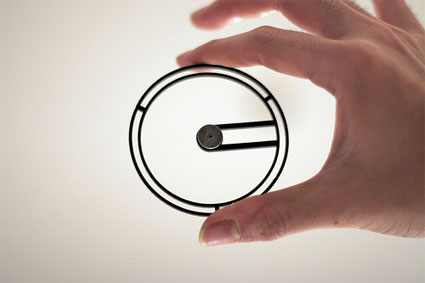
Sound Jewellery
Sound Jewellery conceives sound as something precious that you can offer to a friend or wear as a memory of a shared laugher, a romantic conversation, any sound moment from your daily life. The record is made up of components which of course you can play but they can also be worn as bracelet, brooch or other pieces of jewellery.
Related: Turntable Orchestra, Computer/Turntable hybrid, The Turnatable Microwave, video turntable, the Tri-phonic Turntable, etc.
All images courtesy of Yuri Suzuki.
The works are on view at RCA until July 5, 2008.
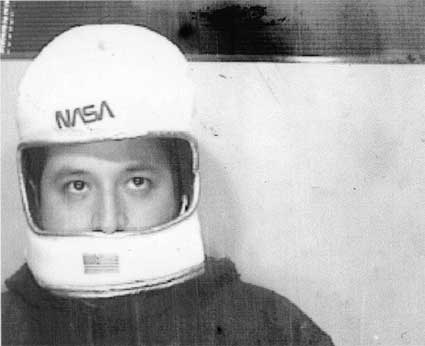
I’ve discovered Fernando Orellana in 2004, the year i realized that there were artists playing with technology out there. All along my tumultuous and whimsical 4-year relationship with new media art, artists have been appearing and disappearing from my BVBMA (Best of the very best media artists) list. I’m slowly moving away from the entertaining, the merely playful, the very geeky, the strictly techy and i’m now looking for something called “an artistic experience”. Well, Fernando’s installations are quite geeky in a sense and some are even playful but, no matter how you define art, i’ve always found something extremely meaningful and touching in Fernando’s work: a robot dreams, others are unable to make a decision, an elevator appears to be self-aware and a vintage radio relentlessly searches for God. Needless to say, Fernando’s work has always amazed me and i can see in my crystal ball that it’s going to be that way for the years to come.
The artist has uploaded several videos about his work on you tube. As a starter, here’s an ABC news segment on his robotic art piece “Sleep Waking”:
When i first met you in Gijon at the opening of the exhibition Emergentes, you told me about the personal story behind 8520 S.W. 27th Pl. v.2 (don’t miss the video of the robot assembly), an installation about the pointlessness of our never ending decision making process. Can you share it with the readers?
8520 S.W. 27th Place is the address of the home I grew up in Davie, Florida after my family moved from El Salvador in 1979. It is in a housing development called Rolling Hills. I’ve linked it in Google maps.
For the most part, my siblings and I assimilated and became part of American culture. Subsequently we grew up in the burgeoning suburban sprawl that has now swallowed southern Florida into an endless ghetto of cookie-cutter dream homes. This is what frames a large portion my childhood memories. Neatly cut lawns. Driveways with two-car garages. Manicured gardens adorned with transplanted trees. Swimming pool parties. Mosquito nets. Packaged people living out their packaged lives. Day in. Day out.
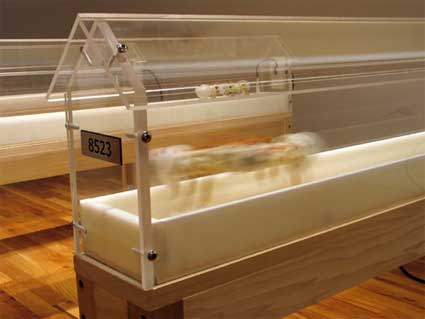
8520 S.W. 27th Place, 2004
This imagery is what fueled the aesthetic for this 8520 S.W. 27th Place. I wanted to reference the suburban dwelling that millions of other people worldwide grew up in as well. I thought it this would be the appropriate stage for a sculpture that speaks of humanities’ decision-making process. It is within the walls of these prefabricated, automated homes that we ceaselessly make decisions about everything; from the type of partners we want, to the garnishing on our pizza delivery, to what color we want our IPods. Endlessly. Back and forth. From the moment we are born till the day we die.
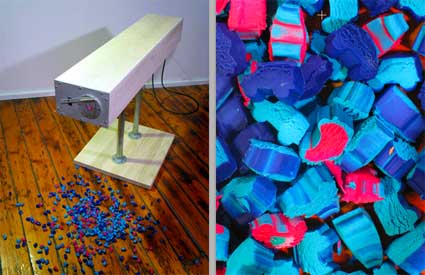
Extruder, 2008
How did you come up with Extruder? Where did you get the idea of making a machine that makes play-doh cars?
I arrived at the idea for Extruder from a couple different places. It branches from a series of drawing machines that I made a couple years back. Extruder started because I wanted to make a machine that could make sculpture. I had been doodling designs for this mechanism for years. I suppose funding issues kept them from materializing until now.
This last summer I made a series of paintings that spoke of war, dismemberment, IEDs, and automobiles. During that process, I came to appreciate the impact that the automobile has made on this world. I read a statistic that still baffles me when I think about it now. There is one car for every 11 people in this world, roughly 590 million passenger cars total. The automobile is involved in everything. From pancakes to penicillin, Play-Doh to parking lots.
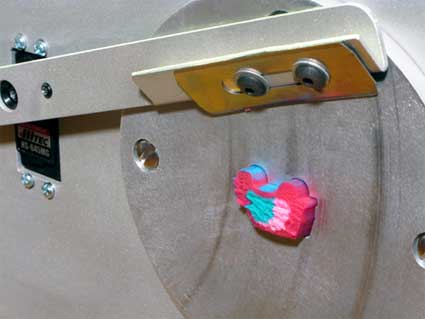
Extruder, 2008
I developed Extruder as a response to this machine that we worship. I wanted to celebrate it. Criticize it. Emulate it. Making hundreds of Play-Doh cars. Millions. The ultimate goal of Extruder is to make the total number of automobiles that were made in 1947 (the year Henry Ford died) by the Ford motor company, an estimated 429,674. As you can imagine that is also a whole lot of Play-Doh; about 11 tons. Until May 11th 2008, Extruder will be making Play-Doh cars at the Mandeville Gallery at Union College in Schenectady, NY. When the next venue emerges to exhibit it, the process will continue.
The colors that Play-Doh comes in were also a nice reference to my recent paintings. Vivid primaries and secondaries, suggesting the Technicolor cartoon reality that we in the developed world live in. Entertainment for the masses, delivered in candy-wrapped doses of violence, humor, and erotica.
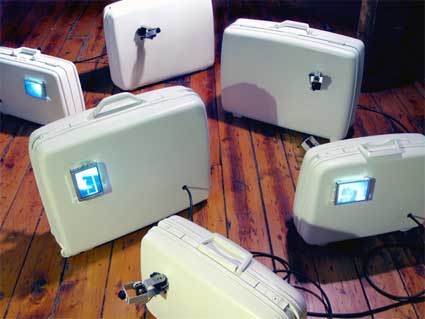
Carry On
The Carry On installation features a series of suitcases fitted with robotic arms and micro-cameras which survey their surroundings. Why did you feel the necessity to develop a work that explores surveillance and paranoia? How much impact on the public can artists have when they comment on surveillance technology?
Carry On is a direct reaction to post-September 11th paranoia, both in the USA and abroad. Since the attacks, I have traveled quite a bit. On these trips, I have passed through countless security and surveillance systems, always hunting for the would-be terrorist. Subway cars now display and sometimes speak “Report ANY Suspicious Activity”. If you happen to look even slightly of Arab descent, you may think twice about growing a beard or wearing your traditional garb. Leaving your luggage or backpack alone in an airport or a train station, even for a moment, could lead to a cavity search.
Holding a miniature video camera, on one side of each suitcase in Carry On is mounted a two axis robotic arm. The live video feed from this camera is displayed on a LCD screen mounted on the other side of the suitcase. Every couple of minutes, the robots change the position of the cameras, thus changing what is being displayed in the LCD screens. Lacking image analysis of any kind or other sensory capability, these suitcases blindly look about, never understanding what they see.
I’m not sure what impact artists make when they reference surveillance technology. Perhaps it may give a person a moment of peace or clarity. Realizing that, like the artwork in front of them, the whole affair of paranoia and fear based politics is an illusion; clever clockwork designed to create the reality they want us to believe in.
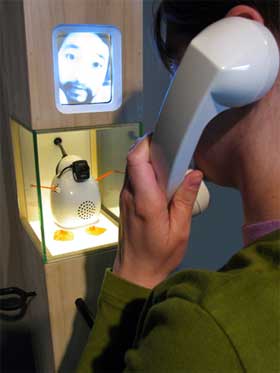 I saw that images of one of your recent project, Phoney. What is the work about?
I saw that images of one of your recent project, Phoney. What is the work about?
Phoney is a toy. It is a kind of absurd videophone. There are two terminals to the piece. The terminals are installed in separate parts of a gallery, with no line of site between them. Each terminal is fit with an old-school telephone receiver, a video screen, and a black and white camera attached to the head of a modified mechanical toy. When a person speaks into the telephone receiver of one terminal, their voice makes the mechanical toy on other terminal dance. This causes the video image they are looking at to shake, since the camera on the other side is attached to the mechanical toy. If two people are involved, a bizarre and sometimes funny conversation can commence. To me the piece references the countless methods or proxies that we now communicate through and the ridiculous information that we pass through them.
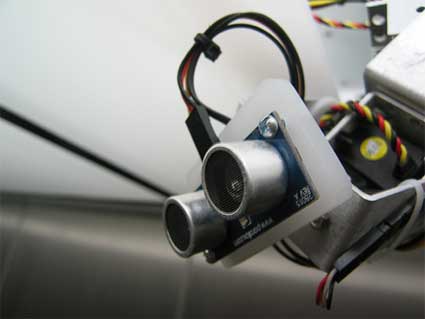
Elevator’s Music, 2007
I read that your work is about “creating systems that seem to be alive”. How much life is there really in your artworks? and how would you define such kind of life?
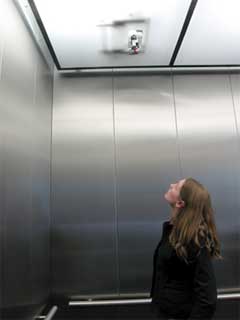 The key part in the quote above is this: “seem to be alive”. My machines are not alive. They never will be. I have become much more interested in the simulation of living systems. It is remarkable how easily we anthropomorphize things, especially things that are in motion. The perception of what humans will assume or believe to be alive is where much of my robotic work is headed.
The key part in the quote above is this: “seem to be alive”. My machines are not alive. They never will be. I have become much more interested in the simulation of living systems. It is remarkable how easily we anthropomorphize things, especially things that are in motion. The perception of what humans will assume or believe to be alive is where much of my robotic work is headed.
The latest iteration of this investigation is Elevator’s Music, a site-specific robotic sculpture that I exhibited in an elevator at the Tang Museum in Saratoga Springs, NY in the winter of 2007. It consisted of four small robots that emerged from the elevators translucent ceiling panels. When people entered the elevator, the robots would sense them and might emerge. Fitted with sonic sensors and having the ability to maneuver in three axes, they were programmed to seek out and respond to near and far objects. If a robot found something near by, it would try and interact with it via randomly determined mechanical gestures and a watery stream of sounds. The robot would also send a message to the other three robots (through a local network), informing them that it had found something of interest. This would cause all robots to look in the direction of the object, causing a kind of musical symphony to commence. If the object was somehow to close, or if nothing was found, they would recoil back into the safety of their ceiling panels.
With this relatively simple set of instructions the elevator robots were able to illicit innumerous reactions from their passengers. Some believed that the robots were watching them or trying to attack them in some way, while others became enamored with them, whistling and talking to them like one would to a pet bird. When one of the robots failed (as all robots eventually do), passengers reported it immediately to museum officials, feeling empathy for the hurt machine. Future robotic sculptures that I design will foster this tendency to assign anthropomorphic qualities to inanimate objects. Through this investigation I hope to arrive at more sophisticated and realistic artificial life simulations.
Video of “Elevator’s Music” at the Tang Teaching Museum at Skidmore College in Saratoga Spring, NY
What can technology developers or scientists learn from digital artists like you? Is there any reason why they should pay more attention to what crazy artists are doing?
I like to think they should pay more attention. In this country there is a general undervaluing of fine art and art education. Art departments all over the nation are the first to suffer from severe budget cuts. The argument that art is not a “mission critical” subject has dominated the establishment for decades. The problem with this of course is that students become completely illiterate to the visual culture all around them. In engineering and science I think this becomes a handicap. The engineer or scientist that can beautifully communicate their findings will undoubtedly fair better on the world stage. Moreover, those engineers or scientists that are willing to experiment with ideas that seem pointless or ridiculous may arrive at discoveries, innovations, and conclusions that otherwise might have eluded them. Perhaps “crazy artists” do have something to teach, other then just being dismissed to be irrelevant or a waste of time.
What is your favorite gadget or bit of technology and why?
It would have to be my laptop. I basically live inside it (or through it?). That aside, I have to say that I am a huge space technology nerd. I read everything and anything about space. Spirit and Opportunity, the two rovers scooting along on mars, or Voyagers one and two, speeding out of the solar system at this very moment are like aphrodisiacs to me. In fact I have a number of art projects that I am just waiting to develop specifically to be put into zero-g environments. Hopefully by the time I am retiring, this will be a possibility! In classic nerd style however, I would first need to over come the crippling and ridiculous sea-sickness I suffer from, sometimes even on sea-side docks.
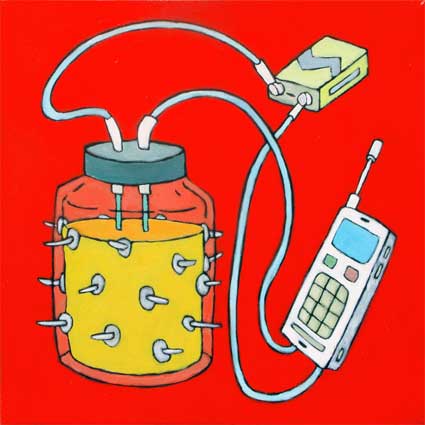
Nail Jar, 2007
What are the common factors between your media art installations and your paintings? Or maybe they have nothing to do with one another?
Painting and drawing is something I have always done. It was my doorway into art and in many ways it keeps me balanced. Until recently, the subjects I painted came from the schools of dada or surrealism, seemingly from my subconscious. This all changed in my recent work. Without really knowing why, last summer I started tackling the subjects I was exploring in my electronic sculptures in the paintings. Painting allows me to quickly approach different angles or points of view within a subject, some of which would not be possible in media sculptures due to funding or physical limitations. It is also a way for me to quickly explore new ideas, some of which are now leaving the canvas surface and becoming sculptures.
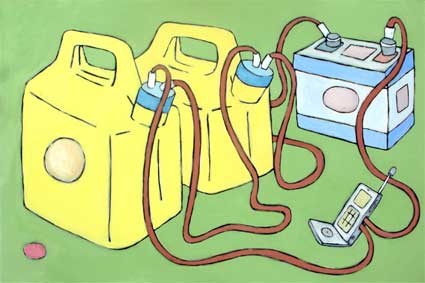
Gasoline, 2007
You are also developing an electronic art program at Union College in Schenectady, NY. Can you tell us what the highlights of the program are?
I was hired three years ago to help start an electronic art program at Union College. Our program is one of the few electronic arts initiatives that is jointly sponsored between the Computer Science and Visual Arts Departments. Drawing from aspects of The School of the Art Institute of Chicago and The Ohio State University’s Art and Technology programs (both of which I graduated from), we have created a thorough course of study, covering topics in digital imaging, video, 3D modeling, physical computing, experimental computer programming, web-design, interactivity, and animation. We have worked hard to make the program as cross-disciplinary as possible, offering courses that computer science, fine-art, and students from other disciplines can benefit from. In many ways the program was a perfect fit at Union College, since it has a long tradition of combining world-renowned engineering within a equally solid liberal arts education.
Any upcoming project or event you could share with us?
There are a couple projects cooking. The most imminent is a real-time video series titled Plain Text. The series plays on the “infinite monkey theorem” which states that given an infinite amount of monkeys, typewriters, and time, the monkeys will type out any particularly text you choose. If one instructs the monkeys (or monkey simulators), to type the King James Bible one of them eventually will. Interestingly, this also includes all the text that you did not choose or any text that might ever be written.
I apply a version of this theorem to a series of short phrases that over an extended period of time cycle through every possible permutation of themselves. For example the phrase:
“You want _ _ _ _ _ _.”
Starting right-to-left, like an odometer only with letters, all the blank spaces in the phrase sequentially cycle through every letter in the alphabet. By this, every word that is six characters long will eventually appear in the phrase above. Differing in theme, amount of blank spaces, and speed, each piece in the series has a different phrase displayed by itself on a large LCD screen.
 For the PluggedIn Exhibition happening in Hudson, NY from May 17th – 30th, two of these phrases will be on display in the vestibules of the Mark McDonald store, along with one large phrase projected on the store’s second floor windows.
For the PluggedIn Exhibition happening in Hudson, NY from May 17th – 30th, two of these phrases will be on display in the vestibules of the Mark McDonald store, along with one large phrase projected on the store’s second floor windows.
Thanks Fernando!
Technology has been used on billboards for years, displaying everything from the temperature to the current powerball jackpot, but generally, the level of interaction between the viewer and the message is minimal. Therefore, the few billboards that use technology to actually inspire and force that mental interaction really impress me, as does this new billboard campaign for AEG-electrolux laundry machines.
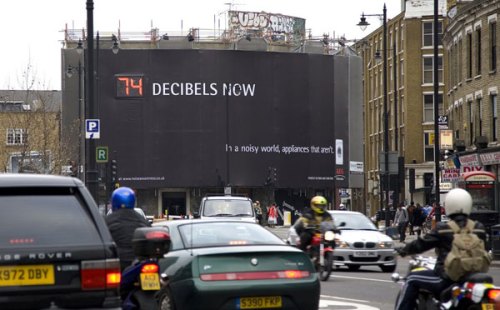
Their somewhat clever “noise awareness” campaign certainly speaks volumes to their product, but it’s the execution of the idea via billboards that really makes it work. Decibel meters monitor the current sound volume. Simple. Nothing too elaborate, and not too much explanation needed. Just enough to make sense, and to push it just a hair past the normal billboard. And of course, the current data is viewable, then compiled and graphed on the well designed Noise Awareness Website, where you can even click on cities to get the exact billboard locations via google maps. Cool stuff.
If you’re lusting for more photos in other cities, check out Notcot.
Another prototype spotted at the RCA work in progress show a few weeks ago in London. This week: In Memory of the Sparrow
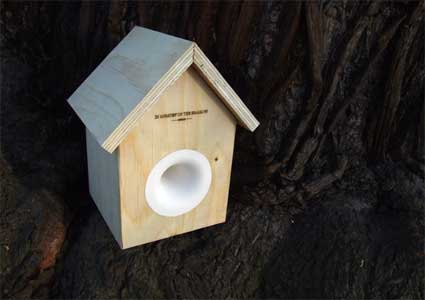
As new wireless technologies are introduced, using various frequencies and power levels, an invisible energy is increasingly altering our habitat. There are no conclusive results from research to indicate the influence of this energy on our health or our environment, but studies have shown that sparrow populations are decreasing in areas that are affected by electromagnetic communication.
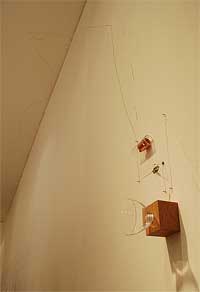
In her scenario, Cathrine Kramer portrays a day when we will walk through a park and meet with an eerie silence. All the birds have disappeared due to an increase of electromagnetic radiation in the urban environment. Inspired by the ‘foxhole radio‘. These simple radios, popular among soldiers during the World War II, need mainly electromagnetic waves as a source of energy.
The object harnesses the very force that drove birds away, and transforms it into subtle bird-like sounds, acting both as a comfort to those who want to remember the sparrows, but also as a poignant reminder that our surroundings contain a level of complexity that surpasses our senses. They are “memorial to the sparrows.”
I asked Cathrine how exactly the bird-like sound was created. “In the exhibition the bird sound was orchestrated, because to work the radio would have to be grounded and this was not possible within the exhibition space,” she explained. “However, in the future scenario I envisioned, these memorials would be mounted to trees and tuned to pick up bird sounds transmitted on an AM frequency bandwidth. The antenna would be a long wire spiraling up the tree to pick up the radio waves.”
All images courtesy of Cathrine Kramer.
This is from an article on BBC back in 2007: “Researchers from Mid Sweden University have constructed an interactive paper billboard that emits recorded sound in response to a user’s touch. The prototype display uses conductive inks, which are sensitive to pressure, and printed speakers.
The key to the billboard’s capabilities is a layer of digital paper that is embedded with electronics. This is printed with conductive inks, which, when applied with pressure, relay information to a micro-computer that contains recorded audio files. Sound then streams out from printed speakers, which are formed from more layers of conductive inks that sit over an empty cavity to form a diaphragm.”
Would make nice packaging. Or talking money, whispering “Spend me.”.
A day of conspiracy theories…
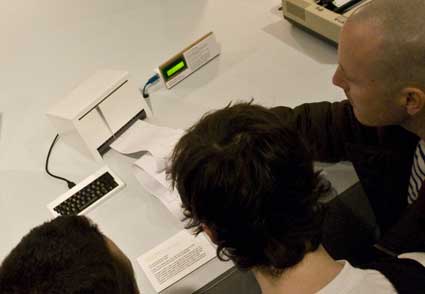
Mi-5 Persecution is the subject line of a series of Usenet posts, originated by Mike Corley, an IT specialist living in London.
His messages usually detail how British intelligence has bugged his home and is sending people to follow him around and harass him. He has also claimed in his posts and on the pages of his own website that television personalities are mocking him or talking about him in code and are part of the MI5 conspiracy. According to him, MI5 with the assistance of the US has started in August 2005 to use a mindcontrol technology which not only reads his mind but can also send voices and thoughts on his mind. This has led to claims that he has mental health issues. Corley has been banned from posting through Google for his abuse of Usenet bulletin boards and has been similarly bounced from most ISPs in England. His story has even been turned into an opera last year.
In the past, his posts were relatively easy to filter out, due to his similar subject lines and email address. However, at the start of 2008, he began a series of posts that avoided filters through sporgery and slightly varying his subject line of “MI-5 Persecution”. The regular expression Subject: {M[‘,-`. ]I[‘,-`. ]5[‘,-`. ]P} will filter this.
Corley Radio, by Design Interactions students Tommaso Lanza and Ross Cairns, is a combination of printer and a radio. It prints out specific words picked up while continuously scanning public and commercial radio stations. Any keywords can be programmed, but in this case they relate to the ongoing Mike Corley story about the MI5 (the UK’s counter-intelligence and security agency) trying to ridicule him through radio and television broadcasts.
The designers imagined that Mike Corley would use the radio to keep track of who is talking to or about him, to help him find all possible conspiracies against him, that he by himself could never possibly detect.

3 questions to Ross & Tommaso:
Is it a working prototype or a concept?
Mechanically it works, however we couldn’t get access to suitable voice recognition software, so for the purpose of the exhibition we faked the print outs based on details from the MI5 Persecution Reports. These are written reports from Mike which he spams to the internet daily at a truly astonishing rate (we’ve set up a crude tracking system recording the number of his posts found on the internet – we know many companies who would love to have this sort of ranking on Google).
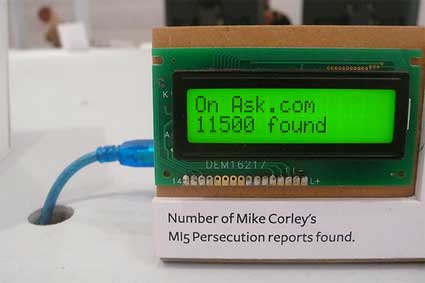
Why choose Mike Corley?
Sometime ago we stumbled across these reports from Mike on Usenet and we started to get obsessively curious as to what they were about. The radio concept alone could be used by anyone. Here in London we could imagine Amy Winehouse or her family using it. A day never seems to go by without some form of unintended tabloid focus on them. However, during this project the story around Mike Corley became increasingly interesting.
I had never heard of that man before so i looked for information about him online and felt very sad for him. Have you tried to get in touch with him?
We know what you mean, it is a strange space we are operating in. This is about a person who is very real and an active part of the ‘uk.misc’ Usenet community. Many of the active community’s members have met him. We have not contacted him (yet). He is constantly receiving nasty replies to his posting from webmasters or forums users. Should we be part of this or passive? Mike is manipulating technology to make his message public and we are feeding off this, highlighting it and using it; but as designers we are very clear about our role. We are not passing judgment on Mike but leaving the project open for interpretation.
Thanks Ross & Tommaso!
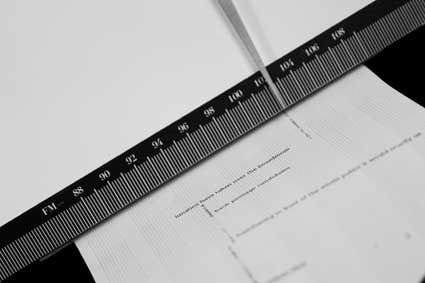
Images 1, 2 and 4 courtesy of the designers.
Antony Hall‘s projects explore the way we interface with technology, and how our interactions with it influence us creatively and socially. Often collaborating with scientists and technologists, Hall is currently focusing his talent on the investigation of biological and physical phenomenon. Some of his recent experiments involve communication with an electric fish, the creation of life through growing crystals electrically on volcanic stone, hunting for Moss bears and training Planarian worms.
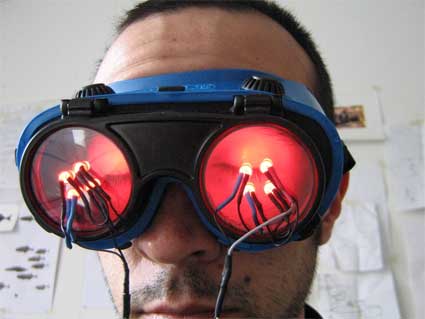
He gained fame in the media and media art festivals with his electro-acoustic sound art devices and performances. Together with Simon Blackmore and more recently Steve Symons, Hall is a founding member of the Owl Project, a group which combines woodwork with electronics to create performances, musical instruments (iLog , and Log1k) and other physical computing projects.
Let’s start with one of your most popular projects: the iLog. How did you get the idea of making it?
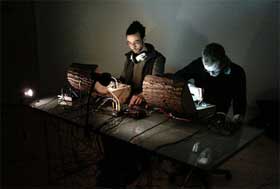 The iLog was created as collaborative project with Simon Blackmore and Steve Symons, we are the Owl Project. We developed the Log1K in 2001 as a performance tool to attempt rival the laptop in electronic music, shortly after this apple started pushing the iPod and we had to make a response, something which related more to the trend for portable, mobile hand held technologies. We wanted our devices to be a synthesis of craft and technology, as well as functional instruments. The Log1ks were getting increasingly heavy, among other things they used nearly 30 AA batteries, short circuits and fires, and blown-out speakers were becoming common place. iLog 01 came out in 2003. After we started collaborating with Steve Symons, we reinvented the electronics inside the iLog and started pushing the whole project to a new level; the M-Log is out later this year.
The iLog was created as collaborative project with Simon Blackmore and Steve Symons, we are the Owl Project. We developed the Log1K in 2001 as a performance tool to attempt rival the laptop in electronic music, shortly after this apple started pushing the iPod and we had to make a response, something which related more to the trend for portable, mobile hand held technologies. We wanted our devices to be a synthesis of craft and technology, as well as functional instruments. The Log1ks were getting increasingly heavy, among other things they used nearly 30 AA batteries, short circuits and fires, and blown-out speakers were becoming common place. iLog 01 came out in 2003. After we started collaborating with Steve Symons, we reinvented the electronics inside the iLog and started pushing the whole project to a new level; the M-Log is out later this year.

There’s now a series of iLog models. Why do you think people buy the iLog? Mainly as a beautiful and quirky piece of art which they would not use too much fearing that it might be damaged (although you provide technical support.)? Or have you found that people use it extensively as any other kind of musical device? Were you expecting your project to have so much success?
I suppose people want the iLog for its quirkiness, something as an alternative to the mass produced items. We had no idea that it would become so popular – people blogged it like mad at the start and like a Chinese whisper it suddenly became what people wanted it to be; typically some kind of alternative to the ipod – But in reality its something quite different. It is intended to be an instrument for performance.
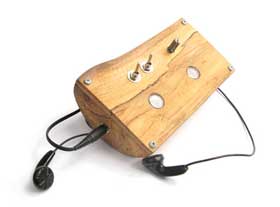
iLog signal
Our problem is that although there is demand; making them is still very difficult, and time consuming, so our focus is making them better rather than faster. At the moment we are looking at lending these to artists and working in collaboration to develop the iLog further. When we launched them for sale in London at DWB it was a real learning curve. Simple things like which way up it should be held, were completely un-obvious! We had to create extensive instructions regarding use, as well as repair and maintenance. The 24 hour support is most necessary! Its important that its more hands on than your average mass produced plastic device.
The iLog is something people can use, rather than living all its life in the art gallery. The new series, *M-Log, launching this year, looks like an iLog, and is a USB connective interface. So there is scope for programming your own sensor based instrument, which you can use with your own customized patch. The iLog is more of a stand alone sound generator. We are planning an event in Manchester during Futuresonic where other performers (including Leafcutter John) will be using the iLogs & M-Logs. *The M in M-Log stands for ‘muio’ as in “muio interface”, the chip based interface inside which Steve‘s invention in his words “The muio interface is a modular system for sensing and controlling the Real World”.
The wood is quite resilient and very repairable if damaged.
I love The Sound Lathe, a performance which explores the sonic properties of wood. Do you have any video of it?
There is some video here:
It does look like a very physical performance. Did you have to master new skills in order to be able to do these performances? How does each performance go? Are they all different from each other? Does working with wood creates situations and results you wouldn’t have expected?
Yes its been really interesting – my self and Simon ended up sleeping in a kind of bivouac deep in the forrest as part or the “R&D” for the project, learning the skills of traditional “green woodwork”, (electricity free) with Mike Abbott, master crafts-person. Mike invented a competition for Bodgers (the name for people who use the ‘pole Lathe’) called ‘Log to Leg’ (as in chair leg) so this is the new format for our performance – I think the record is 9 mins; transforming a bit of tree stump, into two perfect chair legs! It takes us a couple hours, but then our lathe is connected to copious amounts of sensor interface technologies. Quite a distraction, if like for our last performance at Lovebytes, it rained torrentially for the whole thing. In the documentation you will see a tarpaulin underneath that are 3 laptops and Simon.
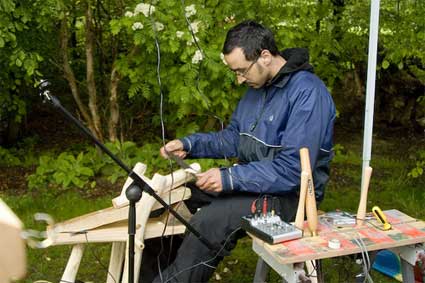
Image Lovebytes
I think for all of us it’s a welcome change from sitting behind a screen the whole time – these physical processes are a great compliment to programming and electronics; and they still require a similar kind of focus and discipline. It is quite exhausting, you need a lot a focus to keep the beat in time as well as make a good carving, in this way it becomes quite mediative. Sharpening the chisels and preparing the timber are all equally demanding skills to learn.
Can you tell us something about the wooden objects produced during the performances? Which kind of objects are there? And what do you do with them once the performance is over?
We have a box full of various objects; ranging in description from ‘chair leg’ to ‘fire wood’, or specialist ‘rolling pin’. Occasionally we have a look inside & discuss what we should do with them. We did make a chair with Mike about the only truly useful thing we ever made. The latest idea is to make some kind of flat pack, or player. Watch this space. You can see what we decide to do with them at The Piemonte Share Festival, 11 – 16 March 2008.
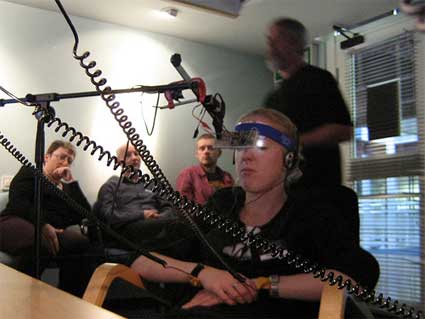
Documentation of first ENKI event at the Museum of Science and Industry Manchester, 7th October 2006
You are also interested in bio-digital medicine. That sounds very different from a project like iLog. Can you explain us what it is and how you started to be interested in this field?
Well this is my own personal project, although I have always working with biology or technological experimentation in some way; with ENKi I decide to humanize what I do. This was a decision to move into medicine and treatment technologies. Really its the same things that we work with in the owl project; looking at how technology is consumed and sold. The notion of bio-digital medicine is just one example in hundreds, of how science, or even the suggestion of science is used, and misused to sell ideas. Faceless corporations feed on our anxieties, our basic need to feel contentment or feel complete. I find it interesting that, just as some people turn to religion, others will look to technology or science to provide answers and solutions.

ENKI uses the bioelectric information from an Electric Fish to trigger human Brain-wave Entrainment. It generates sound and light pulses to induce a state of relaxation similar to the way traditional relaxation systems work, but the electric communication signal comes from an electric fish rather than a chip.
Did you test the system on other people? How do they react?
So far we have tested it on about 40 volunteers,most of them members of the public who had no prior knowledge of the project. We did this in the context of the Manchester Museum of Science and Industry; people enjoy the experience generally. I was surprised at the range of people who were up for it!
By this point I had started working with Greg Byatt as a collaborator. He has experience of using this kind of technology and administering similar treatments professionally. Greg has equipment which can monitor your physiological state and a brain-wave visualiser (EEG); we were trying to measure results this way. We only really came to one solid conclusion. We had to do more tests.
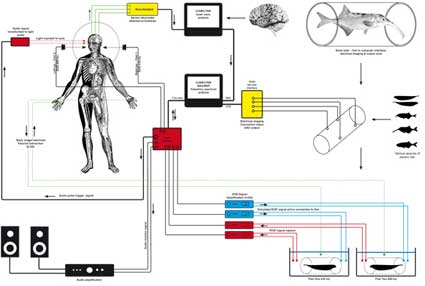
Isn’t the idea of putting one’s “brain-wave entertainment” into the fins of an animal scary? Do you feel that people would trust any other electronic device more than a fish or any other type of animal?
That is a good question. It’s an exciting notion this whole idea of “wet-wear” interfacing – but not something that should be taken lightly. I don’t like to be on my own if i am doing a test run, and yes I find it very unnerving. I never quite got used to the idea of connecting strangers up to electrodes and the fish. I also worry about the fish. The fish needs to be content and ‘happy’ for this to work.
In my opinion that most of these commercial devices are made by various humans all of whom have different intentions and issues, namely cost efficiency; and so effectively using quite crude means; cheap microchips. The Black Ghost knife fish is the result of millions of years of evolutionary refinement; but you could still say the same of micro chips.
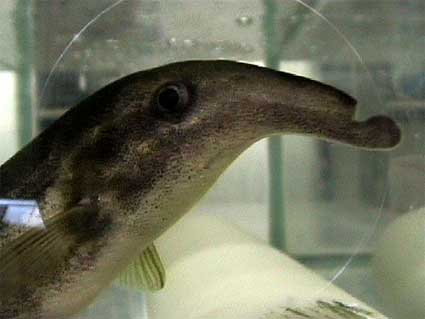
A Down poker
Is that project completely developed or is it still a work in progress?
It’s in progress. I started working with “electrogenic” fish in 2005; ENKI technology was the title I gave it in 2006 when I was in residence at ENSAD in Paris. This was the point I realized I could create a treatment technology that might actually be functional. I had a bit of pressure to actually finish something and so launched the basic concept of ENKI technology. The funny thing was that reflecting on it now – that just marked a new beginning. (It took a year just to convince the director of Pepiniere that it was in fact a real project and not some conjecture in science fiction!). Coming to think of it I have never really finished anything, I am much more excited by the notion of continued experimentation. I don’t want to finish discovering. The more I work on ENKI – the more things there are to do and try, it keeps opening up. There are always more questions.
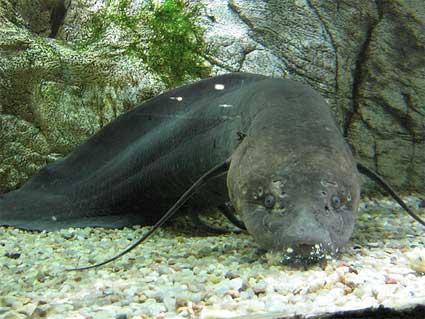
What is there left to achieve? And how much have you learned about cross-species communication?
There is still a lot to achieve. The ‘treatment’ side is just one layer of the onion. I started the project with the aim of communicating with the fish, generating an electrical signal and transmitting this in the fish in the tank, to the fish. Then I watch the the fish, looking for behavioral ‘interactions’ with the electrodes – generally if there is an electrical (connective) change to the electrodes, the fish is aware of this and investigates the electrode by swimming near it and around it (motor-probing responses). I also listening for a ‘chirp’ response. The ‘chirp’ response is a subtle modulation of the Electric signal, a specific fluctuation in the wave. The ‘chirp’ is used during like species interaction and communication. This is closer to the idea of language we have.
Experimentally there are factors which make this difficult to measure – The fish learns to associate the vibrations created by me entering the studio & opening the tank with a food reward. So any approach to the tank needs to be made silently, and the fish needs to be ‘conditioned’ to learn this over a long time. As the project progressed I became more interested in communication as something closer to an idea of commune. For the fish I see the communication signal they make more as a deep expression of self; a projected physical extension of the fish body, rather than ‘language’ in an anthropological sense. This communication is happening at a more primal level. In terms of the ENKi project I am thinking about this as a biological, or physiological connection between living organisms.
I recently discovered that I might be having a problem with what is known as ‘superstitious’ behavior in the fish; if I was a scientist in the academic sense, this would be a serous flaw in the project; something to fix, but for me it was a fantastic turn, giving the project a new angle all together. Its now becoming an experiment into animal Psychology, not just electro physiology. I don’t want to say too much about this next phase but next year the project will look quite different.
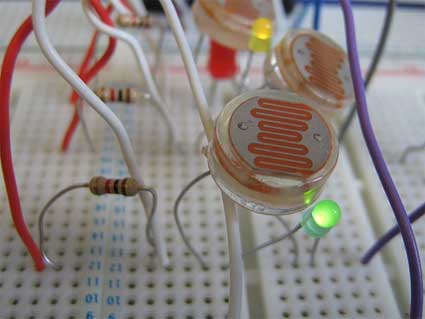
You recently developed the Opto-acoustic modulator and used it for an interactive work at FACT and Liverpool John Moores University for the National Science and Engineering Week. Can you give us more details about this interactive piece? How does it work? What were you trying to achieve with this project?
The commission was to create and interactive art work that used something other than keyborad or mouse. I was determined not to use a video camera either. The the Opto-acoustic modulator basically turns sound-waves into light-waves. It can take 10 audio channels and convert these into “AM” transmissions through 10 Light Emitting Diode arrays. I am fascinated by the notion of ‘Amplitude Modulation’ sending data using light waves. The idea was to use ‘Hyalite’ salt crystals, to broadcast sound through their ‘ionizing’ ambient glow. You interact with the light and can detect the data as sound using wearable sensors. Additionally, using Steve’s ‘muio’ interface again, 8 light sensors detect movement around the crystals using a lens and light sensor (based on the idea a simple biological ‘camera eye’) these feed into MAX MSP controlling a soundscape.
I read on your statement page that you are currently “working on new experiments relating to the creation of life through growing crystals electrically on volcanic stone, hunting for Moss bears (Tardigrades; Fresh water extremophiles) and training Planarian worms. ” Could you already tell us a few words about these experiments?
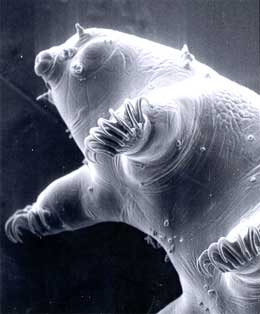
I have been researching the work of William Cross for quite a while, and finally decided that I needed to recreate his experiments (with a few modifications) It’s quite interesting trying to work out what he did – the only way to know is to recreate it. In 1837, he found these creatures “Acari electors” as he called them infesting an experiment, he believed that these things “spontaneously generated” within his experiment, several eminent scientists of the time recreated the experiment with the same results! My experiment is basically a recreation of this experiment, augmented with a little more technology – with the aim of capturing this phenomena of electrochemical abiogenesis. The only problem is the experiment has to run for many months.
I am interested in all sorts fresh water microscopic life; its a great 19h century tradition. With a decent microscope, you can take any roadside moss cluster and explore the interstitial oceans of liquids trapped between damp moss filaments. Here you might be lucky enough to find a Moss Bear ( “Tardigrade” ) an obscure form of extremophile that lives in moss. Believe it or not, it really does look like a bear! This in its self was a reason for laboring days over a microscope just to see if it was real! They don’t fit into the zoological classification system, and have been given a phylum of their own. It is believed it is able to survive space travel, and at this moment a small space capsule orbits the earth containing some “Tardinauts” (its hard to compete with that) I simply enjoy looking for them. I like to go looking for moss growing in all kinds of areas, from urban waste lands, to the Peak District. “Tardigrades” are able to survive about 120 years in a dehydrated state; I was sifting through very old moss samples from Manchester Museum to see if I could reanimate 100 year old dehydrated Moss Bears. apparently it is possible. I had a lot more luck looking for the living ones. Unfortunately my one Planarian worm recently went missing in the tank. It is 8mm long, and I dont have the heart to keep it in a petri dish. I am not sure where it is.
Is there any artist or researcher whose work has been particularly inspiring for you?
I don’t know where to start! Louis Bec for sure. I am really into what SymbioticA have been doing over the past few years, and what they are doing for the “Bio-art” movement. Otherwise, at the moment I am looking at the work of William Bebe. To be honest – I have been trying to read a lot more science fiction lately, particularly 19th century science fiction, and science writing. Often the science fiction tells you a lot about the popular understanding of science at the time. More importantly, its a good antidote ploughing through contemporary research papers.
Thanks Antony!
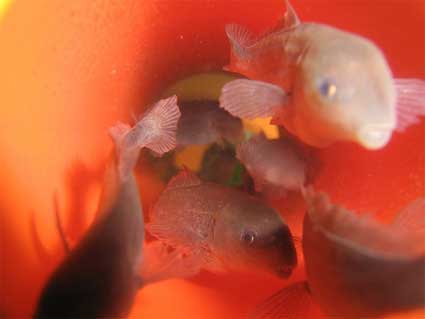
Related: El Niuton has a slideshow dedicated to the work of Simon Blackmore.